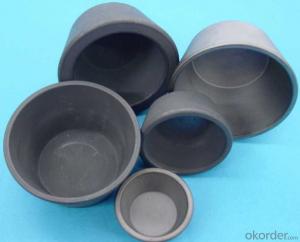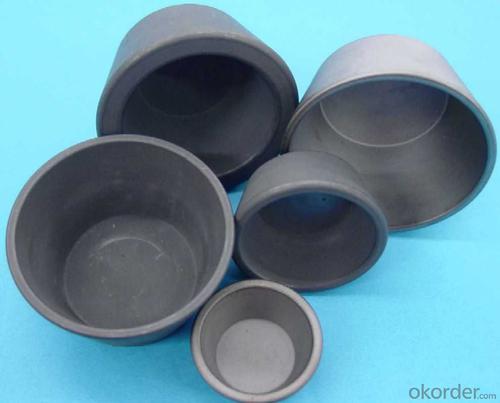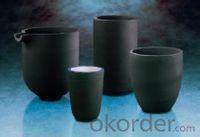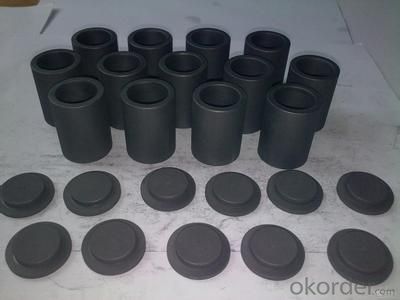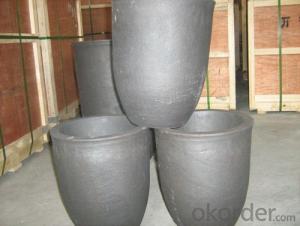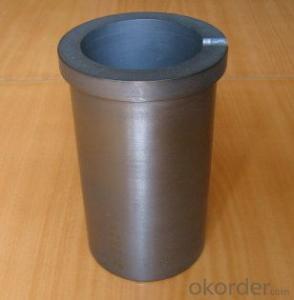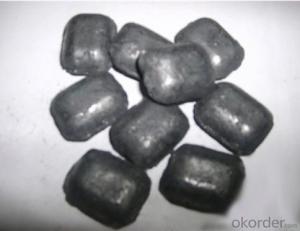Graphite Crucible/High Quality CNBM Graphite Crucibles
- Loading Port:
- China main port
- Payment Terms:
- TT OR LC
- Min Order Qty:
- 0 m.t.
- Supply Capability:
- 100000 m.t./month
OKorder Service Pledge
OKorder Financial Service
You Might Also Like
Specifications
1. SIC graphite crucible
2. high pure and density
3. high strength crucible
4. ISO 9001
5. high heat condduction
Product Description
A crucible is a container used to hold metal for melting in a furnace and it is needed to withstand the extreme temperatures encountered in melting metals. The crucible material must have a much higher melting point than that of the metal being melted and it must have good strength even when white hot.
Graphite crucible can withstand the high temperature, and has good resistance to chemical erosions and thermal shock. Especially graphite crucible is ideal for the melting of aluminum, copper and etc.
Specification
Bulk Density | g/cc | 1.70-1.88 |
Specific Resistance | μΩ.m | 6.0-15.0 |
Compressive Strength | MPa | 30-80 |
Bending Strength | MPa | 20-45 |
Shore hardness | 30-70 | |
C.T.E.(100-600°C) | x10-6 /°C | 2.5-5.5 |
Ash | % | 0.01-0.2 |
Maximum Grain Size | mm | 0.044-0 |
Usage
1. Graphite crucible cannot be exposed in moisture, and must be placed in indoor dry place or wooden shelf. Maintain ventilated. Moisture is strictly prohibited. Damped crucible is likely to crack.
2. Each crucible, especially damped ones, must be preheated and roasted in drying equipment or next to a ground furnace before use. The roasting temperature should start from a low temperature of 100°C below. Roast it to 150°C at a speed of not higher than 30°C per hour. Preserve the heat for about 8 hours and then dry it. The crucible dried next to a ground furnace should be placed at least for one shift, and often turned to change direction, till workers feel the internal wall of crucible is hot.
3. The melting time for the first time should be at least twice of the normal melting time, in order to avoid cracking inside the crucible due to heating up too fast, or even cracking immediately when the fire sets on.
4. Handle with care. Falling or shaking is strictly forbidden in order to present cracking. Crucible should be placed below the mouth of furnace to prevent the furnace lid abrading the upper edge of the crucible and thus affecting the capacity.
5. Pour out the remaining cold metals inside the crucible after use, and then add new materials. Carefully and gently add new materials into the crucible. Feed materials according to the capacity of crucible. It is not allowed to feed too many materials, in order to prevent crucible from swelling or bursting.
Picture

- Q: What is the role of carbon in the corrosion of metals?
- Carbon can play a significant role in the corrosion of metals by acting as a catalyst or an electrolyte. It can accelerate the corrosion process by promoting the formation of corrosive substances such as carbonic acid or carbon dioxide. Additionally, carbon can act as an electrolyte in certain environments, facilitating the flow of electrons and ions between the metal and the surrounding medium, thus enhancing corrosion.
- Q: Is graphite carbon?
- Chemically, it belongs to carbonWhen these carbon atoms connect with each other to form a single substance, they have different ways.
- Q: Is the power consumption of carbon fiber heating very high?
- The advantages and disadvantages of carbon fiber heating carbon fiber heating, comfortable and natural advantages of 1: the ground heating source, on the human body at the end of the foot has a good heating, health effects, and health effects of carbon fiber far infrared heating to improve the microcirculation of the human body, make the body feel very comfortable. 2, heating rapidly: carbon fiber thermal conductivity is good, so carbon fiber heating ground heating faster. 3, installation and maintenance cost is low, long service life: carbon fiber heating laying low cost, 100 square meters of house, generally laying price, but 10000 yuan, usually without maintenance, and product life and construction life is quite.
- Q: What is carbon nanotechnology?
- The study and engineering of materials at the nanoscale using carbon-based materials, such as carbon nanotubes and graphene, is known as carbon nanotechnology. This branch of science focuses on manipulating and examining materials at a scale of 1 to 100 nanometers. Carbon nanotechnology takes advantage of carbon's distinctive properties to create and control nanostructures with exceptional mechanical, electrical, and chemical attributes. For instance, carbon nanotubes are cylindrical structures composed of carbon atoms arranged in a hexagonal lattice. Their unique structure grants them remarkable strength, thermal conductivity, and electrical properties. Consequently, carbon nanotubes have a wide range of potential applications in electronics, energy storage, and materials science. They offer the promise of creating stronger and lighter materials, more efficient batteries, and faster and smaller electronic devices. Another carbon-based material, graphene, is a single layer of carbon atoms arranged in a hexagonal lattice. It possesses exceptional strength, electrical conductivity, and thermal conductivity. Graphene has the potential to revolutionize industries such as electronics, medicine, and energy. Its properties make it an ideal candidate for flexible electronics, high-performance batteries, and even drug delivery systems. The development of methods to synthesize and manipulate carbon-based nanostructures is an essential aspect of carbon nanotechnology. Researchers employ techniques like chemical vapor deposition, laser ablation, and molecular self-assembly to create nanoscale carbon materials. These techniques allow for precise control over the size, shape, and properties of the nanostructures, enabling the design of materials with tailored properties for specific applications. In conclusion, carbon nanotechnology explores the unique properties and applications of carbon-based materials at the nanoscale. It has the potential to revolutionize various industries and create new technologies that can bring numerous benefits to society.
- Q: How does carbon affect the formation of desertification?
- Carbon does not directly affect the formation of desertification. Desertification is mainly caused by a combination of natural factors such as climate change, prolonged drought, and human activities like deforestation and overgrazing. However, carbon indirectly plays a role in exacerbating desertification through climate change. Carbon dioxide (CO2) is a greenhouse gas that is released into the atmosphere through human activities, primarily the burning of fossil fuels. The increased concentration of CO2 in the atmosphere leads to global warming, which alters climate patterns and increases the frequency and intensity of droughts. Prolonged droughts can cause soil moisture depletion, making the land more susceptible to erosion and degradation, thus contributing to the desertification process. Moreover, carbon indirectly affects desertification through deforestation. Trees and other vegetation play a crucial role in maintaining healthy soil by preventing erosion, retaining moisture, and providing shade. When forests are cleared, the carbon stored in trees is released into the atmosphere, contributing to increased CO2 levels. Additionally, the loss of vegetation cover exposes the soil to erosion by wind and water, accelerating desertification. It is important to note that while carbon indirectly impacts desertification through climate change and deforestation, desertification itself is a complex process influenced by various factors. Addressing desertification requires a comprehensive approach that involves sustainable land management practices, reforestation efforts, water management, and climate change mitigation strategies.
- Q: What are fossil fuels and how are they formed?
- Fossil fuels are natural energy resources derived from the remains of ancient plants and animals that lived millions of years ago. They are formed through a long process involving the decomposition and conversion of organic matter under high pressure and temperature over geological time. This transformation results in the formation of coal, oil, and natural gas, which are the primary types of fossil fuels.
- Q: How is carbon stored in the Earth's crust?
- Carbon is stored in the Earth's crust in various forms and geological processes. One primary way carbon is stored is through the formation of sedimentary rocks such as limestone, dolomite, and chalk. These rocks are primarily composed of calcium carbonate, which is derived from the shells and skeletons of marine organisms that lived millions of years ago. Over time, these remains accumulate on the ocean floor and are compacted and cemented to form sedimentary rocks, effectively trapping carbon within them. Another way carbon is stored in the Earth's crust is through the process of carbonation. Carbon dioxide (CO2) from the atmosphere can dissolve in water and react with certain minerals such as basalt, forming carbonate minerals like calcite or magnesite. This process occurs naturally through chemical weathering and volcanic activity, and it helps sequester carbon within the Earth's crust. Additionally, organic carbon is stored in the form of fossil fuels such as coal, oil, and natural gas. These fossil fuels are the remains of ancient plants and microorganisms that lived and died millions of years ago. Over time, the organic matter is buried and subjected to high pressure and temperature, undergoing a process called diagenesis, which eventually converts it into fossil fuels. These deposits act as reservoirs of carbon in the Earth's crust. Overall, the Earth's crust acts as a significant carbon sink, effectively storing carbon through various processes such as the formation of sedimentary rocks, carbonation, and the accumulation of fossil fuels. However, it is important to note that human activities, particularly the burning of fossil fuels, are releasing substantial amounts of stored carbon into the atmosphere, contributing to global climate change.
- Q: How is activated carbon produced?
- Activated carbon is produced through a process called activation, which involves heating carbon-rich materials, such as wood, coal, or coconut shells, at high temperatures in the absence of oxygen. There are two main methods of activation: physical activation and chemical activation. In physical activation, the carbon-rich material is first carbonized by heating it to a high temperature. This creates a carbonized char with a high carbon content. The char is then treated with an oxidizing gas, such as steam or carbon dioxide, at temperatures between 600 to 900 degrees Celsius. This causes the char to expand and develop a highly porous structure. The resulting material is then washed and dried to remove any impurities, resulting in activated carbon. Chemical activation, on the other hand, involves impregnating the carbon-rich material with a chemical activating agent, such as phosphoric acid, zinc chloride, or potassium hydroxide. The impregnated material is then heated to temperatures ranging from 400 to 800 degrees Celsius. This process chemically reacts with the carbon, creating a highly porous structure. The activated carbon is then washed and dried to remove any residual chemicals. Both physical and chemical activation methods result in the production of activated carbon with a large surface area and a network of pores. These pores enhance the adsorption capacity of the activated carbon, allowing it to effectively trap and remove impurities, contaminants, and pollutants from gases and liquids.
- Q: How does carbon impact the fertility of soil?
- Carbon has a positive impact on the fertility of soil as it serves as a vital component of organic matter. Organic matter, rich in carbon, improves soil structure, water-holding capacity, and nutrient availability, creating a favorable environment for microbial activity and plant growth. Carbon also aids in retaining essential nutrients, reducing erosion, and mitigating the impact of pollutants, thus enhancing the overall fertility of soil.
- Q: What is carbon neutral energy?
- Carbon neutral energy refers to energy sources and systems that do not produce any net carbon dioxide emissions, meaning they have a neutral impact on the environment in terms of greenhouse gas emissions. This can be achieved through various methods, such as using renewable energy sources like solar, wind, or hydro power, or by implementing carbon capture and storage technologies to offset any emissions produced. The goal of carbon neutral energy is to mitigate climate change and promote sustainable energy practices.
Send your message to us
Graphite Crucible/High Quality CNBM Graphite Crucibles
- Loading Port:
- China main port
- Payment Terms:
- TT OR LC
- Min Order Qty:
- 0 m.t.
- Supply Capability:
- 100000 m.t./month
OKorder Service Pledge
OKorder Financial Service
Similar products
Hot products
Hot Searches
Related keywords
